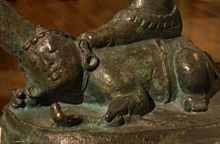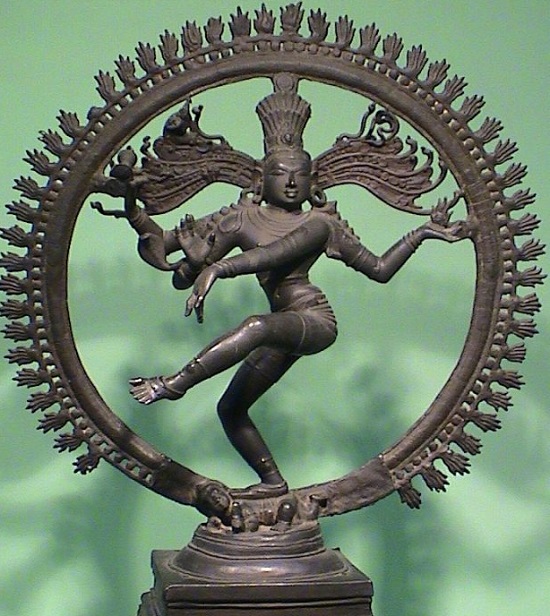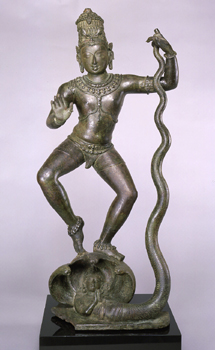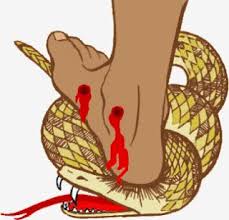What is dance? Theatrical dance encompasses rhythmic movements, meant to be viewed by spectators and tell a story. Dancers coordinate their movements with other dancers, using different parts of their own body, so that their movements generate visual beauty and accentuate rhythm in a repeating time interval, called meter.
The Natya Sastra, the classic work on dance, teaches that entertainment should only be a side-effect of dance but not its primary goal. The goal of music and dance is rasa, transporting the audience into deeper reality, where in wonder they reflect on spiritual and moral questions.
Nataraja of Shiva’s Tandava

So what does Divine Dance look like? The Tandava (Tandavam, Tāṇḍava natyam or Nadanta) is associated with dance of the Gods. The Ananda Tandava dances joy while Rudra Tandava dances anger. The Nataraja represents Divine Dance, with Shiva displayed as Lord of the Dance, in his familiar mudra (position of hands and feet). His right foot is trampling upon demon Apasmara or Muyalaka. However, the fingers point to the left foot, rising high off the ground.

Why does he point at it?
Because that lifted foot, defying gravity symbolizes liberation, moksha. As Unmai Ulakham explains:
“Creation arises from the drum; protection proceeds from the hand of hope; from fire proceeds destruction; from the foot that is planted upon Muyalahan proceeds the destruction of evil; the foot held aloft gives mukti…..”
Krishna dances on demon-serpent Kaliya‘s head

Another classic divine dance is Krishna’s dance on Kaliya. According to mythology, Kaliya lived in the Yamuna river, terrifying the population and spreading his poison throughout the land.
When Krishna jumped into the river Kaliya captured him. Kaliya then stung Krishna, entwining Krishna in his coils, making the onlookers anxious. Krishna allowed this, but seeing the anxiety of the people decided to reassure them. Thus, Krishna jumped on the serpent’s hoods beginning His famous dance, symbolic of the Lord’s leela (divine play), called “Aarabhati”. In rhythm, Krishna danced on the each of the rising hoods of Kaliya, defeating him.
The Cross a Rhythmic Dance on the Serpent’s head
The Gospel declares that the crucifixion and resurrection of Jesus likewise was His dance defeating the serpent. It was both Ananda Tandava and Rudra Tandava in that this dance aroused both joy and anger in the Lord. We see this right at the beginning of human history, when Adam, the first Manu, succumbed to the serpent. God (details here) had said to the serpent
And I will put enmity
Genesis 3:15
between you and the woman,
and between your seed and hers;
he will crush your head,
and you will strike his heel.”

So this drama foretold a struggle between the Serpent and the Seed or Offspring of the Woman. This seed was Jesus and their struggle climaxed at the cross. As Krishna allowed Kaliya to strike him, so Jesus allowed the Serpent to strike him, confident of his final victory. As Shiva tramples on Apasmara while pointing to Moksha, so Jesus trampled on the serpent and made the way to life. The Bible describes His victory and our way to life like this:
When you were spiritually dead because of your sins and because you were not free from the power of your sinful self, God made you alive with Christ, and he forgave all our sins. 14 He canceled the debt, which listed all the rules we failed to follow. He took away that record with its rules and nailed it to the cross. 15 God stripped the spiritual rulers and powers of their authority. With the cross, he won the victory and showed the world that they were powerless.
Colossians 2:13-15
Their struggle unfolded in a rhythmic dance of ‘sevens’ and ‘threes’, seen in the final week of Jesus through Creation.
God’s foreknowledge revealed from beginning of Hebrew Vedas
Of all Sacred Books (Sanskrit & Hebrew Vedas, the gospels) there are only two weeks where the events of each day in the week are narrated. The first such week, recorded in the beginning of the Hebrew Vedas, records how God created everything.
The other week with daily events recorded is Jesus’ last week. No other sage, Rsi or prophet have daily activities narrated for one complete week. The Hebrew Veda Creation Account is given here. We went through the daily events in Jesus’ last week and this table places each day in these two weeks side-by-side. The auspicious number ‘seven’, which forms a week, is thus the base meter or timing which the Creator based his rhythm on.
| Day of week | Creation Week | Jesus’s last week |
| Day 1 | Surrounded by darkness God says, ‘Let there be light’ and there was light in the darkness | Jesus says “I have come into the world as a light…” There is light in the darkness |
| Day 2 | God separates the earth from the heavens | Jesus separates that of earth from that of heaven by cleansing the Temple as a place of prayer |
| Day 3 | God speaks so land rises out of the sea. | Jesus speaks of faith moving mountains into the sea. |
| God speaks again ‘Let the land produce plants’ and vegetation sprouts. | Jesus speaks a curse and the tree withers. | |
| Day 4 | God speaks ‘Let there be lights in the sky’ and the sun, moon and stars appear, lighting the sky. | Jesus speaks of the sign of his return – the sun, moon and stars will darken. |
| Day 5 | God creates flying animals, including the flying dinosaur reptiles, or dragons | Satan, the great dragon, moves to strike the Christ |
| Day 6 | God speaks and land animals come alive. | Passover lamb animals are slaughtered in the Temple. |
| ‘the Lord God … breathed into Adam’s nostrils the breath of life’. Adam started breathing | “With a loud cry, Jesus breathed his last.” (Mark 15: 37) | |
| God places Adam in the Garden | Jesus freely enters a Garden | |
| Adam is warned away from the Tree of Knowledge with a curse. | Jesus is nailed to a tree and cursed. “Christ redeemed us from the curse of the law by becoming a curse for us, for it is written: ‘Cursed is everyone who is hung on a tree.'”(Galatians3:13) | |
| No animal is found suitable for Adam. Another person was necessary | Passover animal sacrifices were not sufficient. A person was required. “It is impossible for the blood of bulls and goats to take away sins. Therefore, when Christ came into the world, he said: “Sacrifice and offering you did not desire, but a body you prepared for me” (Hebrews10:4-5) | |
| God puts Adam into a deep sleep | Jesus enters the sleep of death | |
| God wounds Adam’s side with which He creates Adam’s bride | A wound is made in Jesus’ side. From his sacrifice Jesus wins his bride, those who belong to him. “Come, I will show you the bride, the wife of the Lamb.”(Revelation21:9) | |
| Day 7 | God rests from work. | Jesus rests in death |
Adam’s Day 6 Dance with Jesus
Each day’s events for these two weeks match each other, giving rhythmic symmetry. At the end of both of these 7-day cycles, first fruits of new life is ready to burst forth and multiply a new creation. So, Adam and Jesus are dancing together, making a composite drama.
The Bible says of Adam that
… Adam, who is a pattern of the one to come.
Romans5:14
and
For since death came through a man, the resurrection of the dead comes also through a man. 22 For as in Adam all die, so in Christ all will be made alive.
1Corinthians15:21-22
By comparing these two weeks we see that Adam dramatized a pattern with Jesus yielding rasa. Did God need six days to create the world? Could he not have made everything with one command? Why then did he create in the order that he did? Why did God rest on the seventh day when He cannot tire? He did all in the timing and order that He did so that the final week of Jesus was anticipated already in Creation week.
This is especially true of Day Six. We see symmetry directly in the words used. For example, instead of simply saying ‘Jesus died’ the Gospel says he ‘breathed his last’, a direct inverse pattern to Adam who received the ‘breath of life’. Such a pattern from Time’s beginning shows foreknowledge spanning time and the world. In short, it is a dance of the Divine.
Dancing in meters of ‘Three’
The number Three is considered auspicious since triah manifests Rtam, the rhythmic order and regularity that preserves Creation itself. Rtam is the underlying vibration pervading the whole creation. Therefore, it manifests itself in many ways as the orderly progress of time and events.
It is not surprising then that this same timing is found between the first 3 days of creation and the three days of Jesus in death. This table highlights this pattern.
| Creation Week | Days of Jesus in death | |
| Day 1 & Good Friday | The day begins in darkness. God says, ‘Let there be light’ and there was light in the darkness | The day begins with light (Jesus) surrounded by darkness. At his death the light is extinguished and the world goes dark in an eclipse. |
| Day 2 & Sabbath Rest | God separates the earth from the heavens by moving heavens away from earth | While his body rests, Jesus’ spirit sets the captive dead inside earth free to ascend up to heaven |
| Day 3 & Resurrection First Fruits | God speaks ‘Let the land produce plants’ and vegetation sprouts to life. | The Seed that died sprouts to new life, available to all who would receive it. |
Thus God dances in a major meter (by sevens of days) and a minor meter (in days of three) just as dancers move their bodies in various timing cycles.
Subsequent mudras
The Hebrew Vedas recorded specific events and festivals picturing Jesus’ coming. God gave these so we could know this was God’s drama, not man’s. The table below summarizes some, with links to these great Signs recorded hundreds of years before Jesus lived.
| Hebrew Vedas | How it accentuates the coming of Jesus |
| Sign of Adam | God confronted the serpent and announced the Seed coming to crush the serpent’s head. |
| Noah survives the Great Flood | Sacrifices are offered, pointing to the coming sacrifice of Jesus. |
| Sign of Abraham’s sacrifice | Abraham’s sacrifice location was the same Mountain where thousands of years later Jesus would be sacrificed. At the last moment the lamb substituted in so the son lived, picturing how Jesus the ‘Lamb of God’ would sacrifice himself so we could live. |
| Sign of the Passover | Lambs were to be sacrificed on a specific day – Passover. Those who obeyed escaped death, but those who disobeyed died. Hundreds of years later Jesus was sacrificed on this exact day – Passover. |
| Yom Kippur | Annual celebration involving the scapegoat sacrifice – pointing to the sacrifice of Jesus |
| Like ‘The Raj’: What does ‘Christ’ mean? | The title ’Christ’ inaugurated with the promise of His coming |
| … as in Kurukshetra Battle | The ‘Christ’ would descend from King David, ready for battle |
| Sign of the Branch | The ‘Christ’ would sprout like a branch from a dead stump |
| The Coming Branch named | This sprouting ‘Branch’ was named 500 years before he lived. |
| Suffering Servant for All | Oracle describing how this person serves all mankind |
| Coming in sacred sevens | Oracle telling when He would come, given in cycles of seven. |
| Birth foretold | His virgin birth and place of birth revealed long before his birth |
In dance, there are the major movements of legs and torso, but the hands and fingers also are used to gracefully accentuate these movements. We call these various poses of hands and fingers mudras. These oracles and festivals are like mudras of the Divine Dance. Artistically, they point out details of the person and work of Jesus. Like Natya Sastra enjoined about dance, God has moved in rhythm inviting us beyond entertainment to rasa.
Our Invitation
God invites us to join His dance. We can understand our response in terms of Bhakti.
He invites us to enter His Love as deep as that between Rama and Sita.
Here understand how to receive the gift of eternal life offered by Jesus.